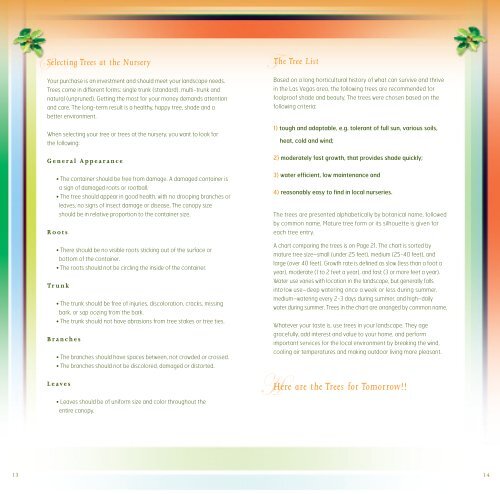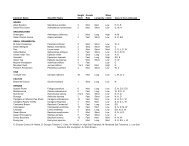trees for Tomorrow.pdf - Nevada Division of Forestry
trees for Tomorrow.pdf - Nevada Division of Forestry
trees for Tomorrow.pdf - Nevada Division of Forestry
You also want an ePaper? Increase the reach of your titles
YUMPU automatically turns print PDFs into web optimized ePapers that Google loves.
Selecting Trees at the Nursery<br />
Your purchase is an investment and should meet your landscape needs.<br />
Trees come in different <strong>for</strong>ms: single trunk (standard), multi-trunk and<br />
natural (unpruned). Getting the most <strong>for</strong> your money demands attention<br />
and care. The long-term result is a healthy, happy tree, shade and a<br />
better environment.<br />
When selecting your tree or <strong>trees</strong> at the nursery, you want to look <strong>for</strong><br />
the following:<br />
General Appearance<br />
• The container should be free from damage. A damaged container is<br />
a sign <strong>of</strong> damaged roots or rootball.<br />
• The tree should appear in good health, with no drooping branches or<br />
leaves, no signs <strong>of</strong> insect damage or disease. The canopy size<br />
should be in relative proportion to the container size.<br />
Roots<br />
• There should be no visible roots sticking out <strong>of</strong> the surface or<br />
bottom <strong>of</strong> the container.<br />
• The roots should not be circling the inside <strong>of</strong> the container.<br />
Trunk<br />
• The trunk should be free <strong>of</strong> injuries, discoloration, cracks, missing<br />
bark, or sap oozing from the bark.<br />
• The trunk should not have abrasions from tree stakes or tree ties.<br />
Branches<br />
• The branches should have spaces between, not crowded or crossed.<br />
• The branches should not be discolored, damaged or distorted.<br />
Leaves<br />
• Leaves should be <strong>of</strong> uni<strong>for</strong>m size and color throughout the<br />
entire canopy.<br />
T<br />
H<br />
The Tree List<br />
Based on a long horticultural history <strong>of</strong> what can survive and thrive<br />
in the Las Vegas area, the following <strong>trees</strong> are recommended <strong>for</strong><br />
foolpro<strong>of</strong> shade and beauty. The <strong>trees</strong> were chosen based on the<br />
following criteria:<br />
1) tough and adaptable, e.g. tolerant <strong>of</strong> full sun, various soils,<br />
heat, cold and wind;<br />
2) moderately fast growth, that provides shade quickly;<br />
3) water efficient, low maintenance and<br />
4) reasonably easy to find in local nurseries.<br />
The <strong>trees</strong> are presented alphabetically by botanical name, followed<br />
by common name. Mature tree <strong>for</strong>m or its silhouette is given <strong>for</strong><br />
each tree entry.<br />
A chart comparing the <strong>trees</strong> is on Page 21. The chart is sorted by<br />
mature tree size–small (under 25 feet), medium (25-40 feet), and<br />
large (over 40 feet). Growth rate is defined as slow (less than a foot a<br />
year), moderate (1 to 2 feet a year), and fast (3 or more feet a year).<br />
Water use varies with location in the landscape, but generally falls<br />
into low use–deep watering once a week or less during summer,<br />
medium–watering every 2-3 days during summer, and high–daily<br />
water during summer. Trees in the chart are arranged by common name.<br />
Whatever your taste is, use <strong>trees</strong> in your landscape. They age<br />
gracefully, add interest and value to your home, and per<strong>for</strong>m<br />
important services <strong>for</strong> the local environment by breaking the wind,<br />
cooling air temperatures and making outdoor living more pleasant.<br />
Here are the Trees <strong>for</strong> <strong>Tomorrow</strong>!!<br />
13 14



